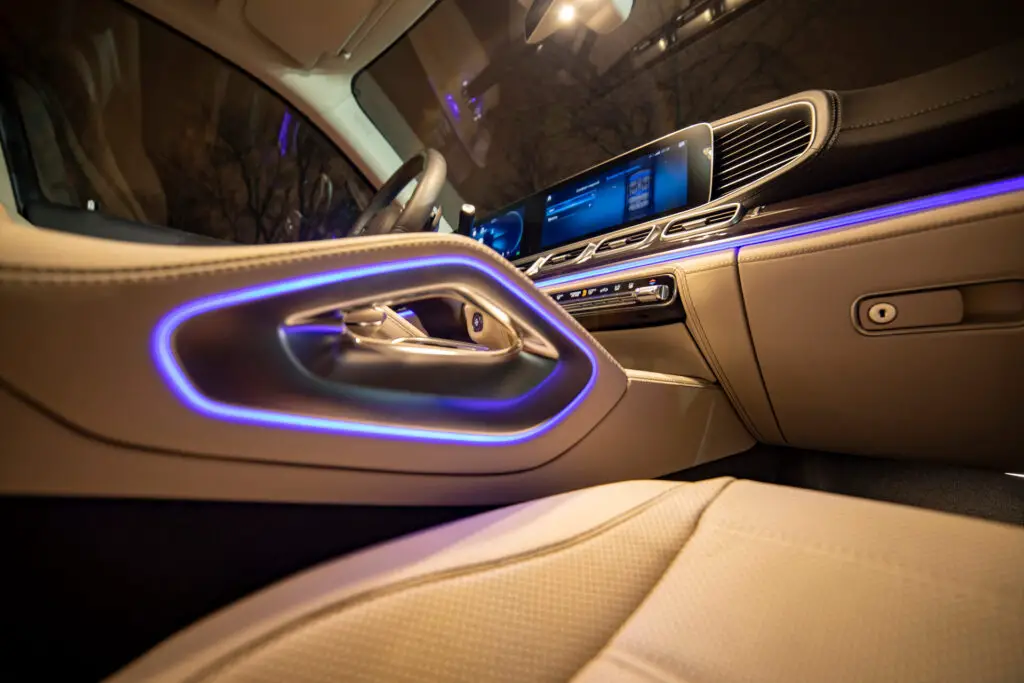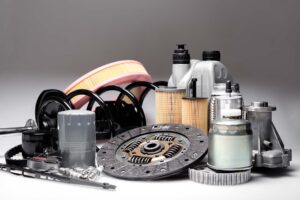Recent surveys show that US drivers spend more and more time behind the wheel on average. If you’re a driver yourself, you’re probably looking for a way to make the time spent in your vehicle more exciting. So, here’s a guide on how to install LED lights in a car and have your trusted four-wheeler look like it’s come straight from the racetracks.
While putting everything together from scratch can be a difficult task, there are many LED light strip kits available on the market, and they make the whole process that much easier. It’s all about having the right plan of placement to ensure the light distributes evenly, and the rest of the job is simply securing the strips with glue or zip ties and connecting the whole thing to a power system.
Add a Burst of Color to Your Vehicle With LED Lights
No matter if you have a brand-new vehicle, a used car, or even one with a salvage title, being comfortable while driving is one of the most important aspects of the whole ordeal. But why not take it a step further, and make it more exciting and beautiful as well?
The long-life LED lights can give the car’s interior and exterior a fresh new look. They add a burst of color to the pavement under your car and also light up the trunk and the footing area so you can easily spot things inside. No more rummaging through and looking everywhere for that one pair of sunglasses you don’t even like that much. With LEDs, the visibility of the interior is just one of the biggest benefits.
What Exactly Are LEDs?
You might know that LED stands for light-emitting diodes, but do you know what that means exactly? Well, these are semiconductor diodes that have an interesting side effect once the voltage is applied – they produce light.
Semiconductors are electronic elements made from silicon and other materials that make way for electrical currents to flow in certain directions. Diodes are actually one-way valves, which means they allow this current to flow only in one direction. The tiny components, such as the semiconductor materials, are very sensitive, so they are sealed in extremely durable and hard housing.

Light Bulbs vs. LEDs – Which One Is Better?
While you definitely won’t be thinking about installing the regular light bulb in your vehicle, it’s still good to be familiar with its basic properties. That way, it’s easier to understand the aspects in which the LEDs are superior. Here’s a brief overview of some of the main pros and cons of both the light bulb and the LED:
| Aspect | Light Bulbs | LED Bulbs |
| Voltage | Low (120V-130V) | Low (1.8V-3.3V) |
| Power Use | Moderate/High | Low |
| Durability and Life Expectancy | Low/Medium (hundreds of hours) | Extremely high (10,000 hours) |
| Cost | Low/Medium | Low |
Are LEDs Energy Efficient?
As you can gather from the table above, LED lights have significant advantages in nearly every category that truly matters. They are extremely durable and can last in the tens of thousands of hours, while traditional light bulbs are subject to failure after a few hundred hours.
But, maybe the biggest advantage of LEDs is that they have a very low energy expenditure. That means that the standard 12V LED strip lights won’t have an impact on your vehicle’s power consumption. When they are powered by car voltage, which is somewhere around 12V, resistors need to be used in order to limit the amount of electrical current that is flowing through. Otherwise, they will burn out too quickly.

LED Strip Lights Are the Best Option for Your Vehicle
LEDs have been around for decades, but in the last ten years or so, they have become gradually more involved in our everyday lives, including home and vehicle lighting. When it comes to installing them in your car, it’s best to go for the LED light strips that contain an evenly spaced set of several RGB (red, green, and blue) LEDs and wired-in resistors.
With this kind of structure, there are basically infinite brightness and color combinations at the tip of your fingers. However, a single-color option is available as well, and while it doesn’t need a power supply, these light strips are incapable of providing different color combinations and other special features like dimming or changing color. When you have a multi-color LED light strip, you can experience all the advanced features, and it’s as easy as a click of a button on your LED controller or phone app.
Get an LED Light Strip Kit to Make the Installation Process Easier
Sure, you can get a simple single-color light set for a really low price, but consider spending a few dollars more in order to enjoy all the features a multi-color option provides. You might be tempted to get all the components and take on this project by yourself from scratch, but there is a way to do it that is much easier.
If you’re not sure what exactly you’re doing, getting the individual components together can be difficult. In order for LED lights to work properly, you’ll need both a power supply and an adaptor. So, it’s a good idea to purchase already prepared LED light kits with USB LED light strips specifically made for motor vehicles. Besides the strips, you will get a power supply that will connect to your car’s lighter socket and a controller for switching between light settings.
Kits like this come ready to go, and they will surely make the installation process quicker and easier. There are a lot of them available online, so look out for ones with the following attributes:
- Multi-color options,
- Installer-friendly,
- Color rotation modes,
- Brightness control,
- Color change with music option.
A Step-by-Step Guide on How to Install LED Lights in a Car
Chances are that you’ve learned how to change a flat tire or a tail light at some point in your driving experience. However, these parts are essential, whereas LED lights are completely optional. Still, if you’re up for a fun experience while cruising down the most famous routes in the US, here’s a step-by-step guide on how to install the LED light strips in your vehicle:
Gathering Everything You Need
The most important part of preparing for the installation of LED lights is, obviously, getting the stuff you need to get the job done. While you’ll need much more supplies and knowledge to do the whole thing from scratch, you will need only a few additional things besides what’s in the box if you opt for a LED light strips kit.
Firstly, you should get additional support for adhesion, such as strong glue or wire ties. The glue will bond well with the metal of the vehicle, and the zip-ties get the job done as well. They’re really useful for keeping wires neat and held together, and they also come in handy for mounting strips to metal braces or wiring underneath the dashboard and seats.
If you want to be extra efficient, you can try attaching small brackets by drilling holes for screws in order to hold the strips in place. It’s a good idea to have a multimeter for measuring the voltage on hand as well.
Mapping Out the Placement of LED Strips
Once you’ve gathered all the supplies you need for the job, it’s time to figure out where exactly you want to place the LEDs. Some areas might seem good, but they can be too hidden and cover the lights once installed. So, plan out a placement that ensures that the glow is visible, and use an equal number of strips spaced evenly. You can test out how the LED lights would look once installed by using a small hand-held light.
Most LED kits come with four light strips, and I recommend putting them symmetrically under the dashboard and the front or rear edges of the front seats. For certain kits, you won’t need to run wiring to the car’s battery, and they can be connected to the stereo or cigarette lighter socket because LEDs use a relatively small amount of power.
The placement of the control box is also something you need to plan out in advance because it needs to be accessible for the controller and somewhere where it can sense sound without any interference. I recommend installing it on one side of the center console so it’s hidden a bit.
Testing Out the Lights With a Temporary Placement
Before you install them permanently, it’s a good idea to use some scotch tape to hold them in place and get a better idea of how they would look. You don’t want to go through the whole process only to realize that they’re not working properly, so plug them in and make sure everything is in order.
You want to ensure that the LED light strips are placed and attached in a way that will prepare them for rough weather conditions, inevitable wear-and-tear, and any of your car’s movements, especially if you own a vehicle for off-road driving. Also, double-check that all measurements are correct to save yourself trouble once you start setting them up.
Cleaning the Area Where the LED Strips Will Be Placed
It might be obvious, but removing any dust particles or debris in the area where the light strips will go is essential for their proper placement. If the area has solidified mud or dog hair, you should thoroughly clean it and then wipe it with a damp cloth sprayed with alcohol for quick drying. Wait for it to dry out and do one last sweep, so no last-minute dust particles cause any problems in the long run.
Installing the LED Light Strips
Installing the LED Light Strips
They are self-adhesive, so simply strip the paper from behind the light strips and place them in their prepared spaces. However, the stickiness is often not reliable, so you should use additional strong glue or zip ties to secure them well and ensure they will endure any rough conditions or repeated hits.
In order to power the LED set, you will need to hardwire it to an accessory wire and ensure a 12V supply that will switch on and off with the ignition. The wires right for the job can be found in several places – behind the stereo, at the fusebox, or at the cigarette lighter socket. Once everything is connected, the fun of testing out different options can finally start!
The Possibilities for Customizing Are Endless
It’s time for the fun part, so use the remote or the featured app to switch the LEDs on and try out the different settings. You can match the color to your vehicle’s paint or try different kinds of light atmospheres, from dimming to color rotation. If you have the option, matching the LEDs to the beat of the music might turn out to be your favorite setting.

Once You Get the LEDs, You Might Fall in Love With Driving All Over Again
When the glue has dried, and the lights are plugged in, it’s time to enjoy the unique and exciting atmosphere LEDs bring to your vehicle, especially when driving at night. Who knows, maybe you’ll take a long way home once in a while just to enjoy it a little bit more. Have fun, and remember to always stay safe on the road!








